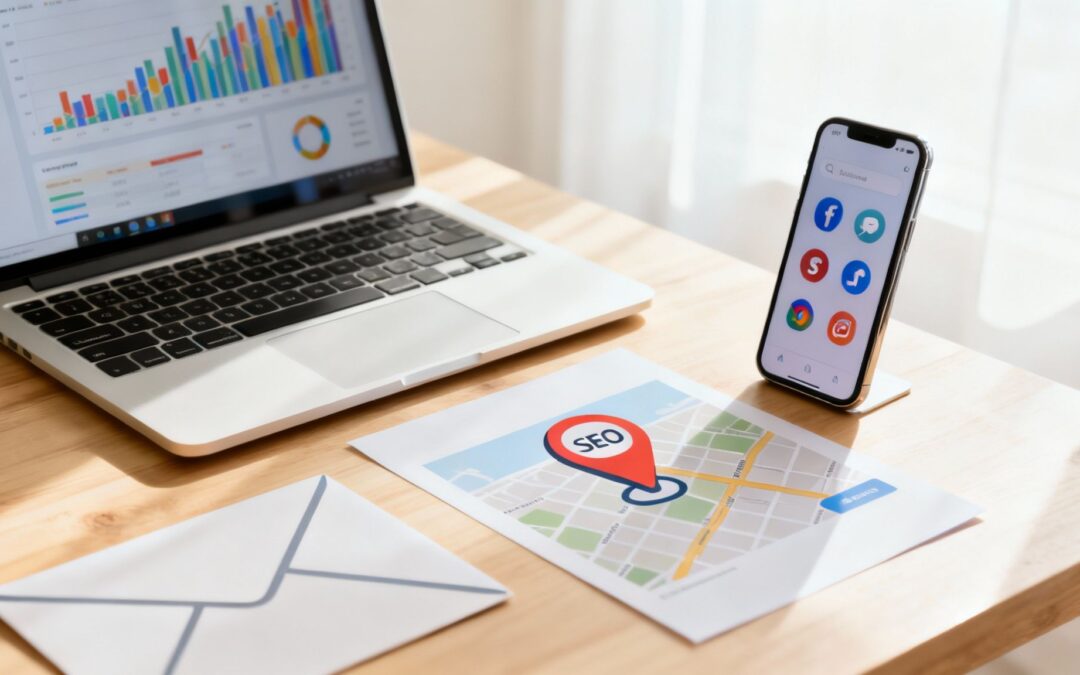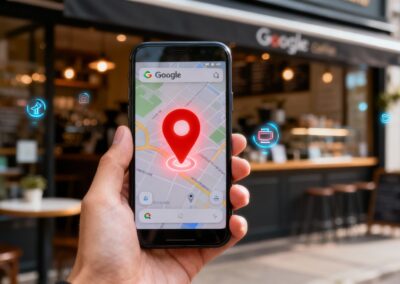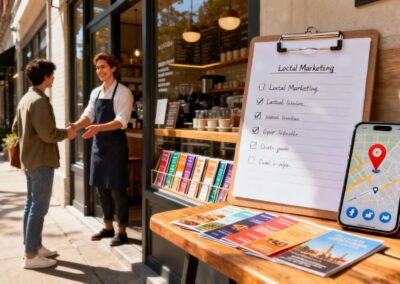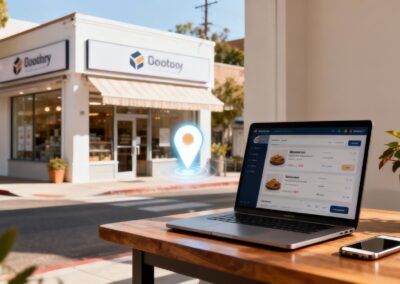Running a small business is a juggling act. Between managing operations, serving customers, and keeping the books, marketing can feel like another mountain to climb, especially with a tight budget. But what if you could make a real impact without breaking the bank? The good news is, you can. Effective digital marketing isn't about having the biggest budget; it's about using the right strategies smartly. This guide cuts through the noise and delivers eight practical, real-world digital marketing tips for small business owners ready to grow.
We will skip the confusing jargon and get straight to actionable steps you can implement today. From optimizing your online presence to connecting with customers through targeted campaigns, each tip is designed for maximum impact with minimal spending. You will learn how to turn your website into a sales machine, leverage customer reviews to build trust, and use local SEO to bring more foot traffic through your door. Think of this as your roadmap to smarter, more efficient marketing that boosts your bottom line.
These foundational strategies are designed to work together, creating a robust marketing system that supports your company's growth. For a broader perspective on essential strategies, explore more Top Digital Marketing Tips for Small Businesses to ensure long-term success. Now, let's dive into the specifics.
1. Optimize Your Google Business Profile
Your Google Business Profile (GBP) is arguably the most powerful free tool in your local marketing toolkit. It’s the detailed business snapshot that appears in Google Search results and on Google Maps when customers look for businesses like yours. For small businesses, this is often the very first impression you make, acting as a digital storefront that can either attract or deter potential customers. A well-maintained profile tells Google you're active and relevant, which significantly boosts your local search ranking.
Think of it as the modern-day phone book listing, but with rich, interactive features. A local restaurant, for example, can see a 35% increase in foot traffic just by regularly adding high-quality photos of its dishes and ambiance. Similarly, a home service business like a plumber or electrician can generate dozens of direct calls each month from their GBP listing alone. It’s a crucial entry point that directly connects searchers with your services.
How to Maximize Your Google Business Profile
Getting started is simple, but consistent management is key. One of the most important digital marketing tips for small business owners is to treat your GBP as a dynamic part of your online presence, not a "set it and forget it" task.
Here are actionable steps to take today:
- Achieve 100% Profile Completion: Fill out every single section Google provides. This includes your business name, address, phone number, website, hours, and service areas. The more complete your profile, the higher Google will rank it.
- Choose Specific Categories: Don't just list "Restaurant." Be more specific, like "Italian Restaurant," "Pizzeria," or "Family Style Restaurant." This helps Google match you with more qualified search queries.
- Upload Fresh, High-Quality Photos: Aim to add new photos at least once a week. Showcase your products, your location, your team, and happy customers. Visuals build trust and engagement.
- Actively Manage Reviews: Respond to all reviews, both positive and negative, within 24-48 hours. Thank happy customers and professionally address concerns from unhappy ones. This shows you value customer feedback.
- Use Google Posts Weekly: Share updates, announce flash sales, highlight new products, or post about company news. These posts appear directly in your profile and signal to Google that your business is active.
2. Leverage Email Marketing Automation
Email marketing remains one of the most powerful and cost-effective digital marketing tips for small business owners, delivering an average ROI of $42 for every $1 spent. Automation takes this a step further, allowing you to send timely, personalized emails based on user behavior without lifting a finger for each send. It’s your secret weapon for nurturing leads, building customer loyalty, and driving sales around the clock.
Think of it as having a dedicated salesperson working 24/7. An e-commerce store, for example, can automatically recover 15-20% of would-be lost sales by sending a simple abandoned cart email sequence. A service business can use a "drip campaign" to educate new leads, systematically guiding them toward making a purchase. It’s a vital strategy that transforms your email list from a simple broadcast tool into a sophisticated sales and retention engine.
How to Maximize Email Marketing Automation
The goal of automation isn't just to save time; it's to deliver the right message to the right person at the right moment. This builds a stronger connection with your audience and drives better results than generic, one-size-fits-all email blasts.
Here are actionable steps to take today:
- Start with a Welcome Series: Don't just send one welcome email. Create a 3-5 email sequence that introduces new subscribers to your brand, highlights your best products or content, and offers an initial incentive.
- Segment Your Audience: Group subscribers based on their interests, purchase history, or how they signed up. This allows you to send highly relevant content that resonates, rather than generic messages.
- Create Trigger-Based Emails: Set up automations for key customer actions. This includes abandoned cart reminders, birthday or anniversary offers, and follow-ups after a purchase to request a review.
- Provide Value First: Structure your emails to educate, entertain, or solve a problem for your subscribers. Build trust by offering valuable content before you ask for the sale.
- Keep Your List Healthy: Regularly clean your email list by removing inactive subscribers who haven't opened your emails in several months. This improves your deliverability rates and ensures you're reaching an engaged audience.
3. Create Valuable Content Marketing
Content marketing is the strategy of creating and sharing valuable, relevant, and consistent content to attract and engage a specific audience. Instead of directly pitching your products or services, you provide genuinely useful information that solves problems, educates, or entertains. For a small business, this establishes you as a credible expert in your field, builds lasting trust with potential customers, and drives organic traffic to your website over the long term.
Think of it as being the helpful answer to your customers' questions before they even know they need your product. A famous example is River Pools & Spas, which transformed its business by creating blog posts that answered every possible question customers had about fiberglass pools. This approach turned their website into a trusted resource, dramatically increasing traffic and sales. Similarly, a local bakery can create recipe videos for social media that not only build a community but also drive foot traffic from viewers eager to try the finished product.
How to Get Started with Content Marketing
The goal is to become the go-to resource in your niche. This is one of the most effective digital marketing tips for small business owners because it creates a sustainable source of leads and builds a loyal audience that trusts your brand. It’s an investment that pays off for years to come.
Here are actionable steps to take today:
- Answer Your Customers' Questions: Brainstorm and list every question you've ever been asked about your industry, products, or services. Turn each question into a blog post, video, or social media post.
- Create a Content Calendar: Plan your content in advance. Aim to publish consistently, whether it's one blog post a week or a daily social media tip. Consistency signals reliability to both audiences and search engines.
- Repurpose Your Content: Turn one great idea into multiple pieces of content. A detailed blog post can become a short video, a series of social media graphics, an email newsletter segment, and a podcast episode.
- Focus on Storytelling: People connect with stories, not just facts. Share customer success stories, the origin of your business, or the process behind making your product. This builds an emotional connection with your brand.
- Include a Clear Call-to-Action (CTA): Every piece of content should guide the audience on what to do next. This could be "subscribe to our newsletter," "download our free guide," or "schedule a consultation."
4. Utilize Social Media Marketing Strategically
Social media marketing for small businesses isn't about being on every platform; it's about being on the right platforms strategically. This means focusing your efforts on the one or two channels where your target audience is most active and engaged. Instead of spreading yourself thin, you can create high-quality content, build a genuine community, and use a mix of organic and paid tactics to boost brand awareness and generate leads.
The key to success is consistency and authenticity, not just follower count. For instance, a local coffee shop can use Instagram Stories to showcase daily specials and behind-the-scenes content, creating an intimate connection with local customers. Similarly, a B2B service provider can use LinkedIn to share industry insights, establishing thought leadership that attracts high-value clients. This focused approach makes social media a powerful, manageable tool rather than an overwhelming chore.
How to Maximize Your Social Media Marketing
A strong social media presence is built on a clear plan and consistent execution. This is one of the most effective digital marketing tips for small business owners because it allows you to connect directly with customers, build loyalty, and drive real business results without a massive budget.
Here are actionable steps to take today:
- Choose Platforms Wisely: Don't join every network. If you sell visual products, focus on Instagram or Pinterest. If you're a B2B consultant, LinkedIn is your best bet. Go where your customers are.
- Follow the 80/20 Rule: Dedicate 80% of your content to providing value like tips, entertainment, or behind-the-scenes looks. Use the remaining 20% for direct promotions and sales pitches.
- Post Consistently and Engage: Create a simple content calendar and stick to it. More importantly, respond to comments and messages quickly to show your audience you're listening and you care.
- Incorporate Video Content: Short-form video (like Reels or TikToks) receives significantly higher engagement than static images. It’s a powerful way to capture attention and showcase your brand's personality.
- Use Platform Analytics: Check your analytics weekly to see which posts perform best and what time your audience is most active. Use this data to refine your strategy and post when you'll get the most visibility.
5. Implement Local SEO Strategies
Local Search Engine Optimization (SEO) is the process of making your business more visible in local search results on Google. When someone types “plumber near me” or “best pizza in Brooklyn,” local SEO is what determines which businesses show up in the top results and on the map. For any small business with a physical location or a defined service area, this is not just a nice-to-have, it's an absolute necessity for survival and growth.
Think about it: a local law firm ranking #1 for "injury attorney in Miami" can generate hundreds of high-value leads every month. Likewise, a home contractor that appears in the coveted Google "Local 3-Pack" for emergency repair searches gets the first call. It’s one of the most effective digital marketing tips for a small business because it connects you with high-intent customers at the exact moment they need your services, driving real-world foot traffic and phone calls.
How to Implement Local SEO Strategies
Getting started with local SEO involves signaling to search engines that you are a legitimate, relevant authority in your specific geographic area. Consistency and attention to detail are the keys to outranking your local competitors. It's about building trust with both Google and potential customers.
Here are actionable steps to take today:
- Ensure NAP Consistency: Your Name, Address, and Phone number must be identical across every single online platform. This includes your website, Google Business Profile, Yelp, and industry-specific directories. Inconsistencies confuse search engines and hurt your rankings.
- Build Local Citations: A citation is any online mention of your NAP. Actively build these on reputable local and national directories like Apple Maps, Bing Places, and the Better Business Bureau. The more quality citations you have, the more credible your business appears.
- Create Location-Specific Content: Develop content that is uniquely relevant to your service area. This could be a blog post about a local community event you sponsored or a dedicated service page detailing your work in a specific neighborhood.
- Generate Local Backlinks: Earn links to your website from other local businesses or organizations. Sponsoring a local charity, joining the Chamber of Commerce, or being featured in a local news blog are excellent ways to get powerful local backlinks.
- Optimize for “Near Me” Keywords: Naturally incorporate location-based keywords into your website content, especially on your homepage and service pages. For example, instead of just "HVAC Repair," use "Affordable HVAC Repair in Springfield."
6. Run Targeted Pay-Per-Click (PPC) Advertising
While organic growth is the long-term goal, Pay-Per-Click (PPC) advertising offers a powerful way to generate immediate traffic and leads. Platforms like Google Ads and Facebook Ads allow you to place your business directly in front of potential customers who are actively searching for your products or services. You pay only when someone clicks your ad, making it a highly controllable and measurable marketing channel.
For small businesses, this is a game-changer. Instead of waiting months for SEO efforts to mature, you can start driving targeted traffic to your website tomorrow. A local service business, for instance, can use Google Search ads to generate quote requests for as little as $15-30 per lead, while an e-commerce store can see an immediate 3x to 5x return on ad spend with Google Shopping campaigns. It's a direct way to buy visibility at the exact moment a customer is ready to make a decision.
The following infographic highlights some key industry benchmarks for PPC campaigns.
These metrics show that even a small, well-managed budget can produce a significant return on investment.
How to Succeed with PPC Advertising
The key to profitable PPC is not a huge budget, but a smart strategy. It's about precision targeting, compelling messaging, and constant optimization. As one of the most effective digital marketing tips for small business owners, starting small and scaling what works is the path to success. For a modern approach, consider exploring the ways of using AI to launch ads, which can help automate and optimize your campaigns for better results.
Here are actionable steps to launch your first campaign:
- Start with a Small, Controlled Budget: You don't need thousands of dollars. Begin with just $10-$20 per day to test your ads, keywords, and targeting before scaling up.
- Focus on High-Intent Keywords: Target phrases that indicate a user is ready to buy, like "emergency plumber near me" instead of just "plumbing." This attracts more qualified clicks.
- Write Compelling Ad Copy: Your ad must grab attention. Include a clear value proposition, a sense of urgency, and a strong call-to-action like "Get a Free Quote Today."
- Install Conversion Tracking Immediately: This is non-negotiable. You must track which clicks lead to actual sales, form submissions, or phone calls to accurately measure your return on investment.
- Use Negative Keywords: Actively build a list of terms you do not want to show up for. This prevents wasted spending on irrelevant searches and improves your campaign's efficiency.
- Optimize Your Landing Pages: Ensure the page users land on after clicking your ad is relevant, fast-loading, and makes it easy for them to take the desired action.
7. Build and Optimize Your Website for Conversions
Your website is your digital headquarters and often the most critical marketing asset you own. It's not enough to simply have one; it must be designed to turn visitors into customers. This process, known as conversion rate optimization (CRO), involves strategically improving your site to increase the percentage of users who take a specific, desired action, whether that's making a purchase, filling out a contact form, or calling your business.
For a small business, CRO is a game-changer. Imagine a service business increases its form submissions by 120% just by reducing the number of form fields from eleven to four. Similarly, an e-commerce store can slash its cart abandonment rate simply by adding trust badges like "Secure Checkout" and a clear progress indicator. These aren't huge, expensive changes, yet they yield significant revenue growth, making CRO one of the most effective digital marketing tips for small business budgets.
How to Build a Conversion-Focused Website
Think of your website as your best salesperson, working 24/7. Your goal is to make it as easy and persuasive as possible for visitors to say "yes." This requires a thoughtful approach to user experience, trust-building, and clear direction.
Here are actionable steps to take today:
- Prioritize Speed and Mobile-Friendliness: Your website must load in under three seconds. Use tools like Google PageSpeed Insights to test and improve performance. Ensure the site looks and functions perfectly on mobile devices, as a majority of traffic comes from them.
- Create Unmistakable Calls-to-Action (CTAs): Your primary CTA button (e.g., "Get a Free Quote," "Shop Now") should be prominent, use a contrasting color, and be visible without scrolling. Make phone numbers clickable for mobile users.
- Simplify Forms: Only ask for the absolute essential information in your contact or checkout forms. Every extra field you add increases the chance a user will abandon it.
- Build Trust Instantly: Prominently display customer testimonials, reviews, security badges (like an SSL certificate), and any professional accreditations. These signals reassure visitors that you are a legitimate and trustworthy business.
- Use High-Quality, Authentic Visuals: Avoid generic stock photos. Use professional images of your actual products, team, or location. Real visuals connect with customers on a much deeper level and build credibility.
8. Leverage Customer Reviews and Testimonials
In today's digital world, customer reviews and testimonials are the new word-of-mouth, acting as powerful social proof that can make or break a small business. Think of them as your most effective, unpaid sales team. When potential customers are undecided, a collection of authentic, positive feedback from past clients provides the trust and confidence needed to choose you over a competitor. This isn't just a bonus; it's a core conversion driver.
The statistics speak for themselves: over 90% of consumers read online reviews before making a purchase. For a local service business, having 40+ Google reviews can dramatically increase their chances of appearing in the coveted Local 3-Pack. Similarly, an e-commerce store that prominently displays product reviews can see an 18% lift in sales. This is one of the most impactful digital marketing tips for a small business because it directly influences both search visibility and buyer behavior.
How to Build a Powerful Review Strategy
Building a strong reputation requires a proactive and consistent approach. You can't just hope for good reviews to appear; you must create a system to actively encourage, manage, and showcase them. This process is a fundamental part of effective online reputation management.
Here are actionable steps to take today:
- Ask at the Right Time: The best time to ask for a review is immediately after a positive customer interaction or successful service completion. Capitalize on the moment of satisfaction.
- Make It Incredibly Easy: Provide customers with a direct link to the review platform you're targeting (start with Google). The fewer clicks required, the higher your success rate.
- Respond to Every Single Review: Reply to all reviews, both positive and negative, within 24-48 hours. Thank positive reviewers and address negative feedback professionally, offering to resolve the issue offline.
- Showcase Your Best Reviews: Don't let your great reviews live only on third-party sites. Display them prominently on your website's homepage, service pages, and even in your email signature.
- Share Reviews on Social Media: Turn a glowing testimonial into a graphic and share it on your social channels. This leverages social proof to a wider audience and reinforces your brand's credibility.
Digital Marketing Tips Comparison for Small Business
| Strategy | Implementation Complexity 🔄 | Resource Requirements ⚡ | Expected Outcomes 📊 | Ideal Use Cases 💡 | Key Advantages ⭐ |
|---|---|---|---|---|---|
| Optimize Your Google Business Profile | Low – Setup and regular updates needed | Low – Free tool, time for monitoring | High local visibility, increased visits | Local businesses, brick-and-mortar stores, restaurants | Free, boosts local SEO, builds trust with reviews |
| Leverage Email Marketing Automation | Medium – Requires setup and learning | Medium – Software subscriptions, content | High ROI, lead nurturing, sales growth | E-commerce, service providers, B2B, content creators | Automated personalization, measurable, saves time |
| Create Valuable Content Marketing | High – Consistent effort and creativity | Medium to high – Content creation resources | Long-term organic traffic and authority | Service businesses, consultants, coaches, B2B, e-commerce | Cost-effective, builds expertise, supports all marketing |
| Utilize Social Media Marketing Strategically | Medium to high – Consistency and engagement | Medium – Content creation, management time | Increased brand awareness, engagement | Consumer brands, local businesses, personal brands, B2B | Direct customer interaction, viral potential, varied budgets |
| Implement Local SEO Strategies | Medium – Ongoing optimization required | Medium – Time for citations, content updates | Higher local rankings, foot traffic | Local services, restaurants, law firms, medical practices | Cost-effective, builds local authority, high conversions |
| Run Targeted Pay-Per-Click (PPC) Advertising | High – Campaign setup and optimization | Medium to high – Ad spend and management | Immediate traffic and leads | E-commerce, local services, B2B, new product launches | Instant results, precise targeting, scalable budget |
| Build and Optimize Your Website for Conversions | Medium – Design and ongoing testing | Medium to high – Development and tools | Increased conversion rates and revenue | All businesses with online presence, especially e-commerce | Maximizes existing traffic, improves marketing ROI |
| Leverage Customer Reviews and Testimonials | Low to medium – Collection and response | Low to medium – Time for requests and replies | Increased trust and higher conversions | All small businesses, especially local services, e-commerce | Builds social proof, improves SEO, free marketing |
Putting Your Digital Marketing Plan into Action
Navigating the world of digital marketing can feel like a huge task, especially when you're already managing the day-to-day operations of a small business. We have covered a wide range of strategies, from optimizing your Google Business Profile to shine in local searches, to building authentic customer relationships through strategic email marketing and social media engagement. We explored how valuable content establishes your expertise, how targeted ads can provide a quick boost, and why a conversion-focused website is your most important digital asset.
The common thread connecting all these tactics is a commitment to consistency and a focus on your unique customer. The most effective digital marketing tips for small business are not about mastering every platform overnight. Instead, they are about taking deliberate, focused steps that build upon each other to create sustainable growth. Your journey begins not by doing everything, but by doing a few things exceptionally well.
Your Actionable Next Steps
Feeling overwhelmed is normal. The key is to transform that feeling into focused action. Here is how you can start turning these concepts into tangible results for your business:
- Conduct a Quick Audit: Take 30 minutes to review your current digital presence. Look at your Google Business Profile, your website's mobile experience, and your most active social media channel. Where is the single biggest, easiest-to-fix opportunity? Start there.
- Pick Your "One Thing": Do not try to implement all eight tips this week. Choose just one strategy that aligns with your most pressing business goal. If you need more local foot traffic, pour your energy into your Google profile and local SEO. If you want to nurture leads, focus on setting up a simple email automation sequence.
- Set a Realistic 30-Day Goal: Break your chosen strategy down into a small, measurable goal. For example, "I will get five new 5-star Google reviews in the next 30 days" or "I will publish two valuable blog posts this month." Achieving small wins builds the momentum you need to tackle bigger challenges.
Mastering these digital marketing fundamentals is not just about increasing website traffic or gaining more followers. It is about building a resilient, adaptable business that can connect with customers, build lasting loyalty, and thrive in an increasingly digital world. Each positive review you earn, every new email subscriber you gain, and every customer who finds you through a local search is a step toward securing your business's future. The power is in starting small, staying consistent, and celebrating your progress along the way.
Turning these digital marketing tips for small business into a cohesive, results-driven strategy takes time and expertise. If you're ready to accelerate your growth and want a dedicated partner to manage the complexities for you, Digital Lotus Marketing is here to help. We specialize in creating and executing data-backed marketing plans that drive real-world results for businesses just like yours. Visit us at Digital Lotus Marketing to learn how we can build your tailored roadmap to success.







